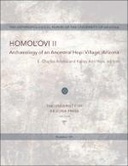Explore

Homol'ovi II
0 Ungluers have
Faved this Work
Login to Fave
Homol'ovi II is a fourteenth-century, ancestral Hopi pueblo with over 700 rooms. Although known by archaeologists since 1896, no systematic excavations were conducted at the pueblo until 1984. This report summarizes the findings of the excavations by the Arizona State Museum of five rooms and an outside activity area, which now form the core of the interpretive program for Homolovi Ruins State Park. The significant findings reported here are that the excavated deposits date between A.D. 1340 and 1400; that nearly all the decorated ceramics during this period were imported from villages on the Hopi Mesas; that cotton was a principal crop which probably formed the basis of Homol'ovi II's participation in regional exchange; that chipped stone was a totally expedient technology in contrast to ground stone which was becoming more diverse; and that the katsina cult was probably present or developing at Homol'ovi II. These findings from the basis for future excavations that should broaden our knowledge of the developments taking place in fourteenth-century Pueblo society connecting the people whom archaeologists term the Anasazi with those calling themselves Hopi.
This book is included in DOAB.
Why read this book? Have your say.
You must be logged in to comment.
Rights Information
Are you the author or publisher of this work? If so, you can claim it as yours by registering as an Unglue.it rights holder.Downloads
This work has been downloaded 36 times via unglue.it ebook links.
- 36 - pdf (CC BY-NC-ND) at Unglue.it.
Keywords
- Archeology
- arizona state museum
- Cotton
- excavated deposits
- excavation findings
- Excavations
- ground stone
- Homolvi Ruins State Park
- Hopi
- Hopi Indians
- Hopi Mesas
- Hopi pueblo
- hopi villages
- interpretive program
- katsina cult
- pueblo society
- regional exchange
- thema EDItEUR::J Society and Social Sciences::JB Society and culture: general
- thema EDItEUR::N History and Archaeology::NH History::NHK History of the Americas
- thema EDItEUR::N History and Archaeology::NK Archaeology
- Villages
Editions

